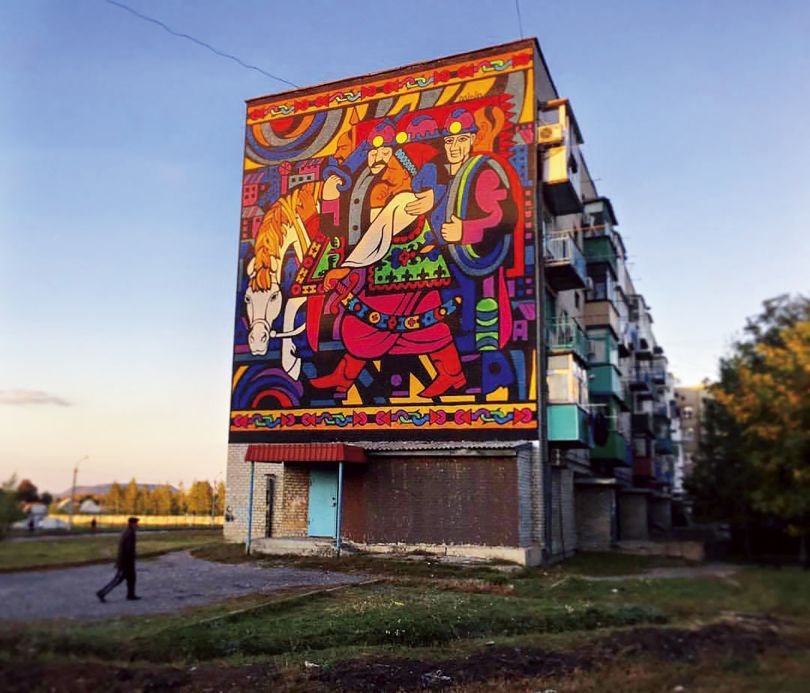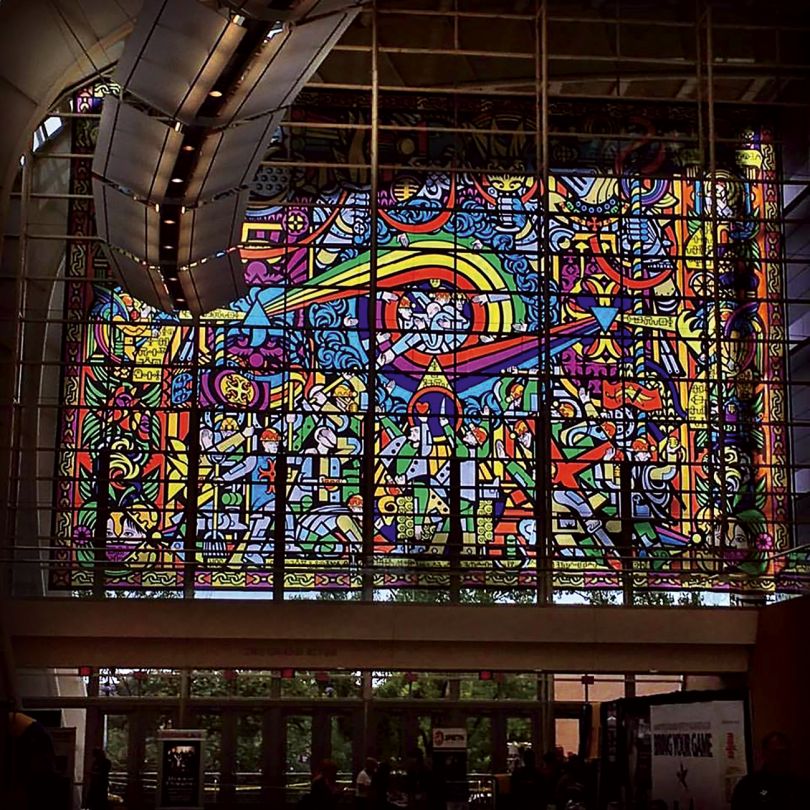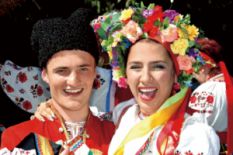Here, in the East of Ukraine, archaic culture fuses with traditional arts and contemporary artistic practices are thriving against the background of Soviet legacy.
Sumy
This heterogeneous nature thrills Yevhen Polozhii, a Sumy-based author:
– It is very interesting to watch the “awakening” of cultural life. This is a challenge for Sumy. Our city life is much slower and quieter than that in neighbouring places. We create certain points of support for culture or, rather, points of resistance to the lack of culture. We recently prepared the first volume in what is planned to be a major series of books on Sumy Region’s cultural heritage and realised in the process that all our promising young artists live in Kyiv. The capital city gives them more opportunities for self-fulfillment.
I think that the Sumy’s time has not come yet. Ours has always been a quiet city, rather provincial, just 40 km away from the border with Russia. Kyiv and Western Ukraine are very sensitive to new influences, and they are more interested in others projects. Nevertheless, I am convinced that Sumy will surprise Ukraine one or two years from now. Private cultural initiatives will emerge. It seems to me that what cities like ours need are highly specialised festivals. Many Ukrainian writers were born in Sumy Region, including Mykola Kulish, Ivan Bahriany, Mykola Khvylovy and Ostap Vyshnya. Maybe we should do a festival of humour. We need to organise our own cultural events. This requires input from individuals.
Poltava
Poltava also relies on individual input for the development of its cultural sector. The region has long been known throughout the country for its museums and traditional folk crafts. In fact, Poltava is known as Ukraine’s spiritual capital. That said, local activists decided in 2017 that the place lacked a contemporary music festival. The journalist Ksenia Malyk undertook to organise one. This resulted in an annual day of street music: every May Poltava turns into a huge open-air musical stage with several dozen locations introducing local residents and city guests to contemporary musicians.
Cultural projects in big cities may not be particularly surprising, but such initiatives in small villages are much more impressive. One such initiative, launched in Poltava Region in 2016, was made possible thanks to the efforts of the Kyiv-based public activist Nastya Melnychenko and Pavlo Tkachuk, a resettler from Crimea. They are the driving force behind the art hamlet Khruli-na-Suli.
Nastya Melnychenko: “One’s own mythology is an indispensable element of such projects’ success as one creates new traditions, fables and legends. We are persistent in working towards our target. As we were launching the Khruli project we would be asked if anyone would be interested at all. Now we have visitors from Belarus, Denmark and all across Ukraine! In January next year we will hold the Malanka carnival Parakhrulstvo in Khruli, and everyone is welcome.”
Zaporizhia
While in Poltava Region people study and transform the local archaic and traditional culture, Zaporizhia is busy reinterpreting the Soviet cultural heritage. Says Natalia Lobach, a coordinator for cultural projects:
– Our initiative group is studying the cultural heritage of constructivism. Known as Sotsmisto, one of the city’s districts was built in the 1920s as an example of the latest achievements in industrial construction. Back then people from all over the world would come to Zaporizhia to admire the latest in urban innovation, including the Dnieper Hydropower Plant and the new avant-garde, modernist principles of life.
Even today the city keeps changing as it reconsiders its heritage and historical achievements.
For the past eight years we have been working on a project devoted to Zaporizhia’s constructivism and socialist heritage. Our conferences are attended by some 100 leading experts from Germany, the Czech Republic and other countries across Europe who are eager to assist us in developing the city’s European vision.
It is very important for me to show this architecture to people, because it is very honest. This architecture shows the true life, the socialist lifestyle, which was aimed at resettling everyone into public housing. This may have sounded romantic in the 1920s, but you can clearly see how all this is totally not about people. Those who lived in such conditions grew accustomed to shifting responsibility for their own lives onto the state, and this habit is still part of our mental heritage. This is about our mentality...
This take on the matter is also interesting to foreign guests. It is very important to understand, analytically, what happens to people when they are forced to live in such conditions, what becomes of them. We promote Zaporizhia as a research laboratory for cultural development.
Victoria Petrova, co-founder and art director of the Zaporizhia New Drama Theatre, highlights the changes to the city’s cultural paradigm:
– It would appear that every time you explain how culture is developing in an industrial city you involuntarily sound apologetic. This may have something to do with an inferiority complex. I really do love Zaporizhia, and there was a period when I saw my mission in proving that it is a cultural centre rather than an industrial city. But now I think: what for? Ours is indeed an industrial city. Yes, it is “a city of simple workers” people often call it. Still, we have an audience that craves for contemporary culture.
It is important for New Drama, this postmodernist theatre, to become part and parcel of our city. Our theatre knows no bounds, it speaks frankly about everything that surrounds us. This is a global trend of using theatre to interpret burning social problems. We invite our audience to join us in looking for solutions to these problems. The challenge is that we have no ready answers. Our theatre is devoid of paternalism, which is unusual for Zaporizhia, but this is why I love the project so much. There is no stage, we perform on the same level with the audience. We transform the space around us into our stage. We do not judge people, events or phenomena.
Kharkiv
Kharkiv offers a completely different story of reintegrating the Soviet heritage. This large city has turned, over the past several years, into a true centre of street art culture. Explorers study Kharkiv’s murals and graffiti, whose creators participate in prestigious exhibitions abroad. Hamlet Zinkivsky, Bob Basset and Roman Minin are wildly popular both in their hometown and beyond. There are even special tours to Kharkiv organised specifically to appreciate their works.
Street art explorer Vyacheslav Omelchenko believes there is good reason for this runaway popularity of contemporary street art:
– Street art has become a brilliant breakthrough for Kharkiv, otherwise a rather bleak city. It all began with simple small-sized pictures and poor-quality murals, which did little to gentrify the city. Then the municipal authorities offered serious support to Hamlet. A mural fest was held in 2017, attended by many European artists and graffitists whose styles were completely different to anything the city had seen before. The street art that appeared just two years ago creates a totally new meaning of urban culture.
Kharkiv street art is special: it appeals to your senses and attempts to make really important statements. The city’s best artists have now moved away from the streets and into galleries: Bob Basset collaborates with European musicians and designers, while Hamlet represented Ukraine at the Venice Biennale, works with writers and illustrates books by famous Ukrainian poets such as Serhiy Zhadan. These artists are changing the city, and the city is revising its attitude towards their artwork.
The stereotype of Kharkiv being an industrial city is outdated. Nowadays, it is also a city of commerce, technology and entertainment. The phenomenon of Kharkiv street art has two levels to it. On the one hand, it is about the sheer visual poverty of post-Soviet cities and buildings. There was neither urban visual culture nor conceptual art in that era. On the other hand, the city as we see it today is just the beginning of its history, a point of growth. Kharkiv is changing pretty dynamically. It offers a different feeling of urban. And this is precisely which makes people visit the city.
Dnipro
It is impossible to discuss important cultural initiatives in the east of Ukraine without mentioning the of current events there. The Dnipro museum of the ongoing anti-terrorist operation is unique not just to its city but to the whole of Ukraine. Since opened two years ago, it has welcomed more than 200,000 visitors from across the country and abroad. European political leaders, members of the European Parliament, foreign diplomats, military attachés of NATO countries and many others come here to learn about the events of recent years and pay homage to those fallen in the fight for Ukraine’s freedom and territorial integrity.
Yuriy Fanygin, historian and co-founder of the museum:
– There are no boundaries when it comes to such kind of work, so we are always happy to welcome new visitors and rejoice at how popular the museum is. The museum is unique in that it does not tell the story of a war that has already ended. We are living this history right here and now, so our perception of the events is different. We also tell the story of those who are currently fighting in the east of Ukraine. They are ordinary people, not some heroes of the past. The museum staff includes actual veterans of this ongoing war, who conduct guided tours.
Our city is unique. For a long time it used to be closed to the world owing to its massive defense sector. For this reason Dnipro lacked its own brand image among Ukrainian cities. In the past five years, however, the place has emerged as an outpostof Ukrainian statehood. It is no coincidence that Dnipro is referred to as Ukraine’s frontline capital.
The cultural landscape of Dnipro began to change following the 2013-14 revolution. This process presents a serious challenge for everyone. At the same time, it is now very obvious that cultural initiatives are not the capital city’s prerogative, that there are also people residing in industrial centres who similarly strive to change their lives through culture. And watching this process makes for an extremely interesting pastime.
"We need to organise our own cultural events. This requires input from individuals".
Olga Babchuk
Photo: shutterstock (3), uk.wikipedia.org, chokolad.com.ua,facebook.com/roman.minin.3









